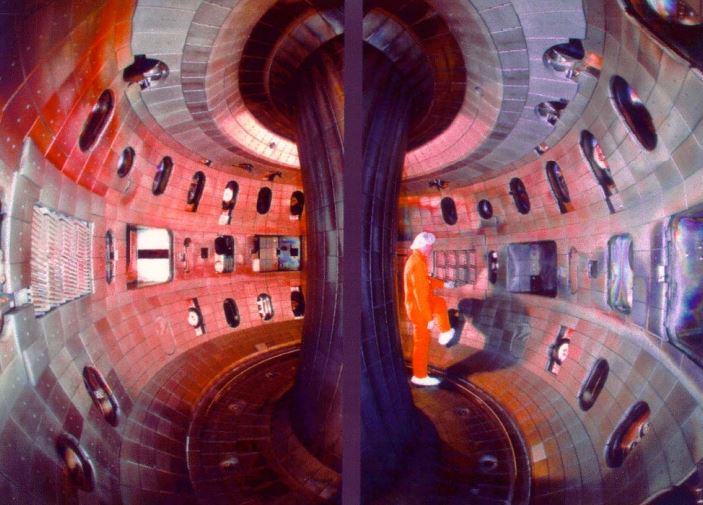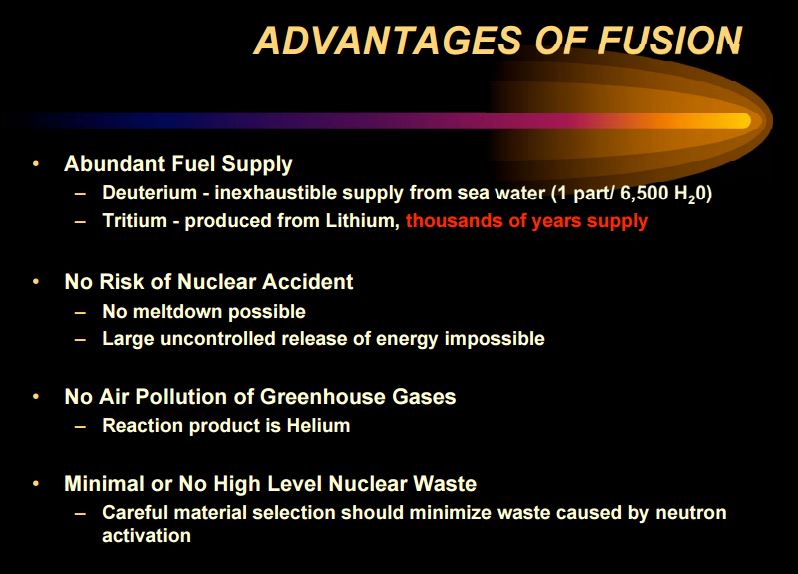Usable fusion energy production is still beyond our scientists, but we may be one step closer, says a US-China research team. They say the way to raise the power and efficiency of magnetic fusion energy could be to risk pushing the plasma – hotter than 100 million °C – closer than it’s ever been to the wall.
Fusion power is the Holy Grail of energy production. It is an effectively infinite supply of fuel, at essentially zero cost on an energy production scale. It would solve two problems: 1. Greenhouse gas emissions and the global warming they appear to be causing. 2. Finding new sources of fuel.
General Atomics says the following about fusion:
“Fusion is the process that powers the sun and the stars. It is the reaction in which two atoms of hydrogen combine together, or fuse, to form an atom of helium. In the process, some of the mass of the hydrogen is converted to energy. Fusion has the potential to be an inexhaustible source of energy.”
 DIII-D Tokamak Operated by General Atomics, San Diego. (Image: fusioned.gat.com)
DIII-D Tokamak Operated by General Atomics, San Diego. (Image: fusioned.gat.com)
This latest study was led by Dr. Andrea Garofalo of General Atomics in San Diego, USA, and Dr. Xianzu Gong of ASIPP (Academy of Sciences Institute of Plasma Physics) in HeFei, Anhui Province, China.
Using both China’s EAST facility and the DIII-D National Fusion Facility, which General Atomics operates for the US Department of Energy, the scientists have investigated the ‘high-bootstrap current’ scenario, which improves self-generated (‘bootstrap’) electoral current to find an ideal tokamak configuration for fusion energy production. Tokamak is a toroidal (doughnut-shaped) steel-lined fusion device for producing controlled fusion reactions in hot plasma.
Harnessing the Sun’s power on Earth
Magnetic fusion energy research uses magnetic fields to confine ionized gas (plasma) heated to extremely high temperatures – hotter than the center of the Sun. In such an environment the ions fuse and release excess energy, which can be turned into electricity, harnessing the power of the Sun on Earth.
The most developed configuration scientists know of is the tokamak, and this research team’s work helps prepare for the 500-megawatt ITER fusion research facility that a consortium of 35 countries, including the US and China, are building in France.
This latest joint China-US experiment demonstrated the stabilizing effect of reducing the plasma-wall distance in tokamaks with high plasma pressure and large bootstrap current faction.
Dr. Gong explained:
“I think, in simple terms, these experiments may provide better physics and operation foundation for ITER plasmas.”
 Image: General Atomics
Image: General Atomics
Running plasma closer to the vessel’s wall
Dr. Garofalo explained that the focus was on resolving a wobbling effect that reduces performance (kink mode), by shifting plasma closer to the vessel’s wall.
Operating closer to the wall eliminates the kink mode and allows for higher pressure within the tokamak, which gives rise to ‘pressure-driven’ plasma flows that maintain the confinement quality, even with lower external injection of velocity.
Dr. Garofalo said:
“This is unlike any other regime. It’s very risky to move the plasma that close to the wall. The chief operator said ‘You can’t do that anymore, you’re going to damage the machine,’ so it was a struggle to prove our theory was correct.”
The strategy paid off. By moving the plasma closer to the wall, the kink mode was gone, which enabled higher plasma pressure, which in turn, reduces the plasma’s dependency on external injected flow.
This is a major breakthrough, because in a tokamak reactor, such as ITER, it is very hard and extremely costly to drive a rapid plasma flow with external means.
The scientists performed the most recent bootstrap exploration in DIII-D, following-up work on the record-setting breakthrough attained at China’s EAST tokamak, where General Atomics scientists have also been collaborating.
Global cooperation vital for success
While scientists have been talking about fusion power since the 1950s, and several teams across the globe have achieved significant advances, this China-US team is setting new milestones in international cooperation.
Dr. Gong believes we will only achieve successful and usable magnetic fusion energy through global cooperation. He cited the EAST/DIII-D joint project as “an efficient and effective new model” for international science collaborations that benefits both the field of study and the participants.
Dr. Gong said:
“We have made a very good start of international collaboration in fusion research between China and the U.S., and we are very proud to be a pioneer in this field,” said Dr. Gong.
57th Annual Meeting of the APS Division of Plasma Physics. November 16-20, 2015. Savannah, Georgia.
Abstract: KI2.00004 “Progress Toward Steady State Tokamak Operation: Exploiting the high bootstrap current fraction regime,” Session KI2: MFE Regime Optimization. 3:00 – 5:00 PM, Tuesday, November 17, 2015. Room: Chatham Ballroom C.
A team of scientists from Japan and the US says it has made a major discovery of a new plasma confinement state.
Video – Is fusion energy becoming a reality?
